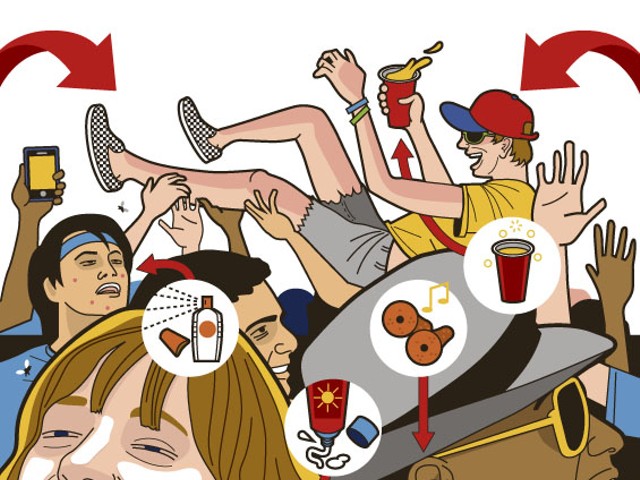You know what's really sad?
"Most St. Louisans know more about the Lake of the Ozarks than they do about the great rivers in their own back yard," muses Rich Meyer, a self-confessed "river rat" who can often be found palling around the Piasa Harbor in Godfrey, Illinois, with guys like Catfish Chris, River John and a man who answers to the name "Mud."
The 75-year-old Meyer and his wife, Pati, keep three boats and four wave runners at the Illinois marina and spend much of their free time cruising the Mississippi River north of Alton.
"We've got our own little sandbar out on the river, not too far from the dock," Meyer says, pointing across the water to a driftwood-strewn islet marked by a tilted and tattered Iwo-Jima-like American flag. "Sometimes we'll have 25 boats tied up out there. Everyone barbecues and plays beach volleyball and flies kites, and the dogs can all run and chomp Frisbees. This is just the best life there is, especially if you collect sunsets like my wife and I do."
When the weather conditions are right, the Alton "pool" above the Melvin Price Locks and Dam is smooth and calm. Meyer acknowledges that there are dangerous eddies, snags and undertows here that you won't encounter in enclosed bodies of water, but he argues the river is worth any extra trouble.
"The Mississippi is so much more interesting than any lake could ever be," he says. "It's got history and spectacular scenery, and you wouldn't believe some of the characters we've seen float by."
Gypsies, Germans on "Huck Finn" rafts, reenactors in dug-out canoes, pilots in amphibious planes: Meyer never gets tired of the strange folks he meets on this mighty inland waterway. Common sense goes a long way to keeping most river boaters safe, says Meyer, who offers up the following ten tips to those looking to make their first sojourn on the Mississippi this summer.
1. A Johnboat Is Not a Freighter
Don't overload your boat. "Most of the time when you hear about a capsizing, it's usually a johnboat meant to hold two people, some fishing poles and a tackle box. Only it's been loaded down with four or five fat men, a cooler full of beer, picnic chairs and a dog — so the bow is sitting about two inches above the waterline. Then a big fast cruiser whips by and swamps it."
2. Water-Ski in Armor
Mayday! Incoming fish! Hordes of Asian carp have overrun the Mississippi, and these jittery twenty-pound torpedoes jump out of the river at the slightest turbulence. "We hold carp rodeos all the time. They leap right into the boat. Those suckers can really clobber you. My daughter grinds them up to use as fertilizer for her organic garden." Wear a hard hat or a helmet when boating or water-skiing, and carry a big net.
3. Drop Anchor When Drunk
"One drunk guy was coming in after dark, and he wasn't familiar enough with the area to be going as fast as he was, as wasted as he was. His boat hit a shallow patch so hard, it just flew out of the water onto our sandbar and flopped over on its side. It took eight guys from Piasa Harbor to push that boat back into the water. The driver was very sober by the time he was afloat once more. Moral of the story: If you're going to drink and boat, drop anchor somewhere, put on your anchor lights and take the keys out of the ignition. And don't move again till you've slept it off."
4. Have an Escape Plan
Drunks are not the only fools on the river, says Meyer. A couple of years ago Meyer was out fishing and saw a man standing up in in a broken-down boat waving to him. Three people were in that boat: the man, his daughter and his granddaughter. They had no paddle, no rope, no anchor, no life jackets, no signals and no cell phones. "If someone hadn't happened by, that grandpa and his family could have just drifted right on down to the dam where they would have been sucked under and drowned. Your boat needs the basic safety equipment in it whenever it's out on the water."
5. Beware the Dikes
Get a good waterproof fishing map or a U.S. Army Corps of Engineers navigation chart to tell you where the sunken hazards are and submerged wing dams lurk. "You have to have the most current map. The Corps is responsible for keeping the depth of the barge's shipping channel at nine feet; they build rock dikes at angles from the shore that are hell on propellers."
6. Know How to Stop
"It's important to remember that there are no brakes on a boat and that it only has three gears: forward, neutral and reverse. Tugboats' captains don't always use a wheel to steer; sometimes they'll change the pitch and speed of their two engines to navigate. Melvin Price Locks and Dam has a barge-pilot simulator in the museum — it's a good place to practice your boating skills."
7. Don't Swallow!
E. Coli and shigellosis are just a couple of the nasty bacteria you can pick up from from drinking untreated river water. But don't let that bother you too much. "I know everyone says the river is nasty, but we swim in it. When it's 100 degrees out and the water is cool, you forget about being too fussy."
8. Check the Current Before You Swim
"Before anybody goes in the water, I always tie a cushion to a rope and drop it in to see how fast the current is moving. If it's strong, everybody wears a life jacket. If it's too strong, nobody goes in. It's too easy to get swept away in those conditions, no matter how strong a swimmer you are."
9. Dogs Need Life Jackets, Too
"Our dogs Rosco and Sasha love the water. As soon as we put their life jackets on them, they know they're going for a boat ride and won't stop barking till they jump into our motorboat. Even water dogs like Sasha need life jackets in the water. Ours have handles on top so we can lug them back into the boat like suitcases."
10. Gas Up
A 57-foot houseboat will burn through about four gallons of gas per nautical mile. "You can't just turn off the engines and float down the current. You need your power on to steer." Always know where your marinas are. (See sidebar, page 14.)






